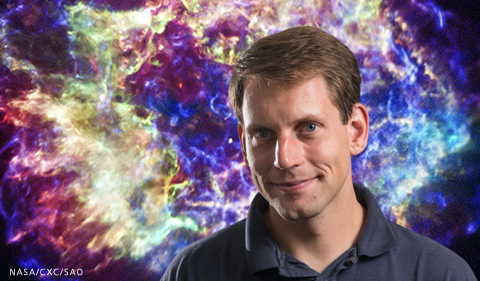Dr. Ryan Chornock, Assistant Professor of Physics & Astronomy at Ohio University, was quoted in a Space.com article headlined “Mysterious ‘Cow’ Blast in Space May Reveal Birth of a Black Hole” about research announced Jan. 10 at the 233rd meeting of the American Astronomical Society in Seattle.
A weirdly bright and brief blast dubbed “The Cow,” which researchers first spotted last June, was likely generated by a newborn black hole or superdense stellar corpse called a neutron star, a new study reports.
…
The Cow was a relatively nearby event: It flared up about 200 million light-years from Earth, in the Hercules constellation. Astronomers discovered the outburst using the Asteroid Terrestrial-impact Last Alert System (ATLAS), a pair of survey telescopes in Hawaii. (The event’s nickname stems from its formal designation, AT2018cow, the last three letters of which were produced using a randomized formula.)
The Cow intrigued researchers from the start. It was incredibly bright — 10 to 100 times brighter than typical supernovae — and surprisingly brief, fading away after a mere two weeks or so.
“We knew right away that this source went from inactive to peak luminosity within just a few days,” co-author Ryan Chornock, an assistant professor of physics and astronomy at Ohio University, said in the same statement. “That was enough to get everybody excited, because it was so unusual and, by astronomical standards, it was very close by.”
The W. M. Keck Observatory reported the results in an article headlined “Birth of a Black Hole of Neutron Star Captured for First Time.”
With the help of W. M. Keck Observatory on Maunakea, Hawaii and the University of Hawaii Institute for Astronomy’s ATLAS twin telescopes, the multi-institutional team now has evidence that they likely captured the exact moment a star collapsed to form a compact object, such as a black hole or neutron star.
The stellar debris, approaching and swirling around the object’s event horizon, caused the remarkably bright glow….
This rare event will help astronomers better understand the physics at play within the first moments of the creation of a black hole or neutron star.
Chornock also was a co-author on an article titled “An embedded X-ray source shines through the aspherical AT2018cow: revealing the inner workings of the most luminous fast-evolving optical transients” will appear in The Astrophysical Journal.
Abstract: We present the first extensive radio to gamma-ray observations of a fast-rising blue optical transient (FBOT), AT2018cow, over its first ~100 days. AT2018cow rose over a few days to a peak luminosity Lpk∼4×1044 erg/s exceeding those of superluminous supernovae (SNe), before declining as ∝t−2. Initial spectra at ≲15 days were mostly featureless and indicated large expansion velocities v~0.1c and temperatures reaching 30000 K. Later spectra revealed a persistent optically-thick photosphere and the emergence of H and He emission features with v~sim 4000 km/s with no evidence for ejecta cooling. Our broad-band monitoring revealed a hard X-ray spectral component at E≥10 keV, in addition to luminous and highly variable soft X-rays, with properties unprecedented among astronomical transients. An abrupt change in the X-ray decay rate and variability appears to accompany the change in optical spectral properties. AT2018cow showed bright radio emission consistent with the interaction of a blastwave with vsh~0.1c with a dense environment (M˙∼10−3−10−4M⊙yr−1 for vw=1000 km\s). While these properties exclude Ni-powered transients, our multi-wavelength analysis instead indicates that AT2018cow harbored a “central engine”, either a compact object (magnetar or black hole) or an embedded internal shock produced by interaction with a compact, dense circumstellar medium. The engine released ∼1050−1051.5 erg over ∼103−105 s and resides within low-mass fast-moving material with equatorial-polar density asymmetry (Mej,fast≲0.3M⊙). Successful SNe from low-mass H-rich stars (like electron-capture SNe) or failed explosions from blue supergiants satisfy these constraints. Intermediate-mass black-holes are disfavored by the large environmental density probed by the radio observations.




















Comments